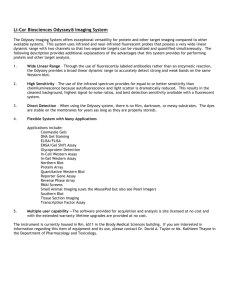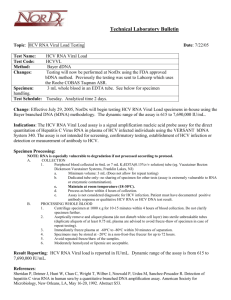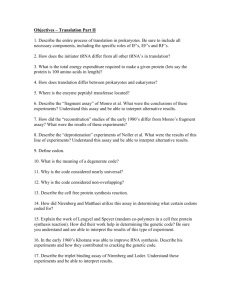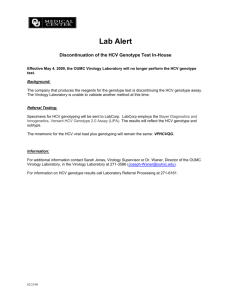Supplementary Information (doc 60K)
advertisement
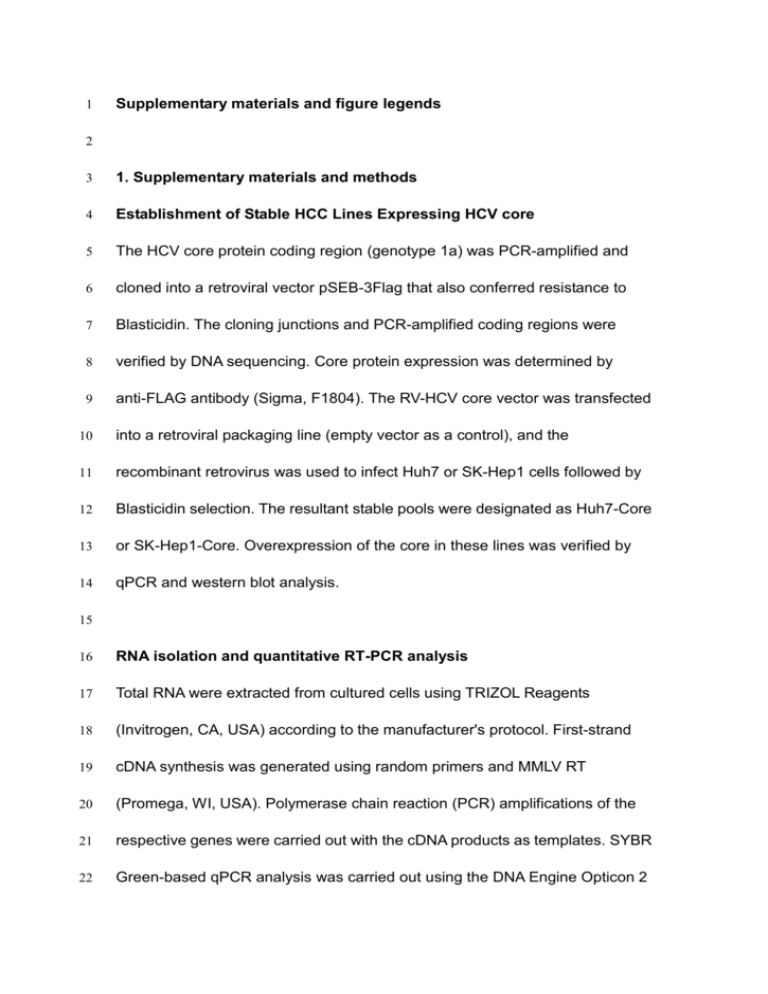
1 Supplementary materials and figure legends 2 3 1. Supplementary materials and methods 4 Establishment of Stable HCC Lines Expressing HCV core 5 The HCV core protein coding region (genotype 1a) was PCR-amplified and 6 cloned into a retroviral vector pSEB-3Flag that also conferred resistance to 7 Blasticidin. The cloning junctions and PCR-amplified coding regions were 8 verified by DNA sequencing. Core protein expression was determined by 9 anti-FLAG antibody (Sigma, F1804). The RV-HCV core vector was transfected 10 into a retroviral packaging line (empty vector as a control), and the 11 recombinant retrovirus was used to infect Huh7 or SK-Hep1 cells followed by 12 Blasticidin selection. The resultant stable pools were designated as Huh7-Core 13 or SK-Hep1-Core. Overexpression of the core in these lines was verified by 14 qPCR and western blot analysis. 15 16 RNA isolation and quantitative RT-PCR analysis 17 Total RNA were extracted from cultured cells using TRIZOL Reagents 18 (Invitrogen, CA, USA) according to the manufacturer's protocol. First-strand 19 cDNA synthesis was generated using random primers and MMLV RT 20 (Promega, WI, USA). Polymerase chain reaction (PCR) amplifications of the 21 respective genes were carried out with the cDNA products as templates. SYBR 22 Green-based qPCR analysis was carried out using the DNA Engine Opticon 2 23 real-time PCR detection system (Bio-Rad, CA, USA). Relative expression was 24 calculated as a ratio of specific transcript to glyceraldehyde 3-phosphate 25 dehydrogenase (GAPDH). Each sample was analyzed in triplicate. The primer 26 sequences are listed in Supplementary Table 1. 27 28 Western Blot analysis 29 Whole cell extracts of exponentially growing cells were collected in lysis buffer 30 (Promega, WI, USA) containing the complete cocktail of proteases inhibitors 31 (Roche, IN, USA). Protein concentrations were determined by using the BCA 32 protein assay reagent (Pierce, IL, USA). Protein samples were separated in 33 10% SDS-polyacrylamide gel and electrotransferred to PVDF membranes 34 (Millipore, MA, USA). The blots were probed with antibodies against HCV core 35 (abcam, ab2740), HCV NS3 (abcam, ab21124), HCV E1 (abcam, ab21306), 36 Flag (Sigma, F1804), SFRP1(Santa Cruz, sc-13939), Dnmt1 (abcam, 37 ab13537), Dnmt3a (abcam, ab13888), Dnmt3b (abcam, ab2851), c-Myc 38 (Santa Cruz, sc-764), cyclin D1 (Santa Cruz, sc-753), β-catenin (Santa Cruz, 39 sc-7199), E-cadherin (Bioworld, BS1098), fibronectin (Santa Cruz, sc-9068) 40 and twist (Santa Cruz, sc-15393). Secondary antibodies coupled to HRP were 41 purchased from Abcam (ab6789). Proteins of interest were detected with 42 Super Signal West Pico Chemiluminescent substrate Kits (Pierce, IL, USA). 43 44 Promoter plasmid constructs 45 The serially truncated SFRP1 promoter fragments, with their 5’-ends ranging 46 from -2030 to -407 and their 3’-end being fixed at +1, were prepared by PCR 47 amplification of human genomic DNA using sense primers containing a KpnI 48 restriction site, and all of the constructs shared the same antisense primer 49 containing a HindIII restriction site (Supplementary Table 1). The PCR 50 products were cloned into pGL3-Basic vector (Promega) and verified by DNA 51 sequencing. 52 53 Dural-luciferase assay 54 Cells were plated in 24-well plates and transfected with 0.5 μg of each deletion 55 construct of SFRP1 promoter (-2030/+1, -1619/+1, -1202/+1, -837/+1 and 56 -407/+1) along with 100 ng/well pRL-TK (an internal control) by using 57 LipofectamineTM 2000 (Invitrogen, Carlsbad, CA, USA). At 16 h after 58 transfection, cells were infected with AdCore or AdGFP. At 24 h after infection, 59 cells were lysed and subjected to dual-luciferase reporter assay (Promega, 60 Madison, WI, USA) following the manufacturer’s protocol. Assays were 61 performed in triplicate and expressed as means ± S.D. 62 63 Immunoprecipitation 64 Huh7 cells were infected with AdCore or AdGFP control. At 24 h after infection, 65 whole-cell extracts were collected and incubated with anti-HDAC1 antibody or 66 anti-Dnmt1 antibody overnight at 4 °C followed by 2 h incubation with protein G 67 agarose beads (Millipore, MA, USA). HDAC1 or Dnmt1 was 68 immunoprecipitated, and the immunocomplex was washed (three times) with 69 RIPA buffer. Samples were then resolved by SDS/PAGE and subjected to 70 western blot assay using anti-core antibody (abcam ab2740). 71 72 Colony formation assay 73 Stable HCC cell lines expressing HCV core (designated as SK-Hep1-Core/ 74 Huh7-Core) or parental cell lines were counted and seeded in 6-well plates 75 with a density of 100 cells per plate. Cells were incubated at 37°C for 3 weeks 76 with growth media replaced every two days. Colonies were stained with 0.5% 77 crystal violet for 25 min and photographed. 78 79 Cell proliferation assay 80 Cell proliferation of HCC lines stably transduced with HCV core protein was 81 examined by BrdU and MTS incorporation assay. For 5-Bromo 82 -2’-Deoxyuridine (BrdU) incorporation assay, Huh7-Core cells or parental cells 83 were infected with AdSFRP1, AdsiDnmt1 or AdSFRP1 plus AdsiDnmt1 84 respectively. At 24 h after infection, cells were incubated with 10μmol/L BrdU. 85 After fixing the cells were reacted with anti-BrdU-peroxidase for 2 h at room 86 temperature, and the color developed after adding trimethyl benzidine was 87 measured at 490nm. For MTS, SK-Hep1 cells were plated in 96-well microtitre 88 plates at a density of 4×103 cells/well and measured at the indicated time 89 points post-plated. Cell proliferation was assessed by adding 20 µl of MTS 90 labeling reagent into each well and incubating at 37°C for 2 h. The plates were 91 read on a microplate reader (Synergy HT Multi-mode Microplate Reader, 92 Bio-Tek) at a wavelength of 490 nm. 93 94 Crystal violet cell viability assay 95 The crystal violet staining procedure was carried out as described.11 Briefly, 96 cells were fixed in 10 % buffered formalin for 20 min and then stained with 97 0.5% crystal violet solution at room temperature for 30 min. The plates were 98 washed with ddH2O and dried in the air, and ultimately incubated with 33% 99 acetic acid to dissolve the dye. Cell viabilities were quantified by measuring the 100 absorbance at 570 nm in a microplate reader (Synergy HT Multi-mode 101 Microplate Reader, Bio-Tek). 102 103 Cell migration and invasion assay 104 In vitro invasion assays were performed using 24-well Transwell unit with 105 polycarbonate filters (Corning Costar, Cambridge, MA). Cells infected with 106 AdSFRP1, AdsiDnmt1 or AdSFRP1 plus AdsiDnmt1 were suspended at 107 density of 5×105/ml in culture medium without FBS and then placed in the 108 upper part of the Transwell. Meanwhile, migration-inducing medium (with 10% 109 FBS) were added to the lower wells of the chambers. Cells were incubated for 110 22 h, fixed with ethanol and stained with 0.05% crystal violet for 30 min. Cells 111 in the upper chamber were removed with a cotton swab. Cells that invaded 112 through the Matrigel (Matrigel™ Basement Membrane Matirx, BD Biosciences, 113 USA) to the underside of the filter (5 fields/filter) were counted. Three invasion 114 chambers were used per treated group. The values obtained were calculated 115 by averaging the total number of cells from three filters. The experimental 116 procedures for in vitro migration assays were the same as the in vitro invasion 117 assay described above except that the filters were not coated with Matrigel. All 118 experiments were performed in triplicates. 119 120 Tumorigenicity assays in nude mice 121 The care and use of experimental animals was in compliance with the 122 institutional guidelines approved for our study. Athymic nude mice (4-6 week 123 old, male, 18-25g) were used for the studies. Huh7-Core or control stable cells 124 were infected with AdsiDnmt1, AdSFRP1, or AdsiDnmt1 plus AdSFRP1 for 15 125 h, and collected for subcutaneous injection (1x106/injection) into the flanks of 126 athymic nude (nu/nu) mice. Four nude mice were included each group and 127 tumor growth was examined every seven days over a course of 8 weeks. 128 Tumor volume (V) was monitored by measuring the length (L) and width (W) of 129 the tumor with calipers and was calculated with the formula 130 V[cm3]=(length[cm)×(width[cm]×(width[cm])/2. At 8 wk after implantation, 131 animals were sacrificed, and tumor masses were retrieved for histological 132 analysis. 133 134 Dnmt1 and HDAC activity assay 135 Nuclear extracts from xenograft samples were isolated using the EpiQuik 136 Nuclear Extraction Kit (OP-0002, Epigentek). Equal amounts of nuclear extract 137 (5 μg) were applied for Dnmt1 or HDAC activity assay (P-336A and P-4002, 138 Epigentek) according to the manufacturer's protocol. Colorimetric assay were 139 performed by measuring the absorbance at 450 nm in a microplate reader 140 (Synergy HT Multi-mode Microplate Reader, Bio-Tek). Dnmt1 and HDAC 141 activity (% of control) were calculated by dividing the sample’s net OD with the 142 vector control’s net OD. 143 144 Immunohistochemical staining 145 Retrieved xenograft samples were fixed with 4% paraformaldehyde, 146 embedded and sectioned. Sections were incubated with β-catenin (Santa Cruz, 147 sc-7199), c-Myc (Santa Cruz, sc-764), SFRP1 (Santa Cruz, sc-13939), PCNA 148 (Maixin-Bio, MAB-0145, China), MMP-2 (ZSGB-BIO, ZM-0330, China), MMP-9 149 (ZSGB-BIO, ZA-0336, China), VEGF (ZSGB-BIO, ZA-0580, China) or Dnmt1 150 (abcam, ab13537) antibodies. Subsequently, the slides were incubated with 151 EnVision System-HRP (Maixin-Bio, Fuzhou, China) and visualized using DAB 152 substrate (Maixin-Bio, Fuzhou, China). 153 154 2. Supplementary figure legends 155 Suppl. Figure 1 Validation of HCV replicon and hepatoma cells stably 156 expressing HCV core. (A) Semi-quantitative RT-PCR analysis of the mRNA 157 expression for SFRP1 to SFRP5 genes after exogenously expressing HCV 158 core in Huh7 cells. Cells were treated as described in Fig. 1 A and the total 159 RNA was subjected to RT-PCR assay. Experiments were performed in 160 triplicate, and representative ones are shown. GAPDH was used as a loading 161 control. * Primer dimers. (B) Infection of permissive Huh7.5.1 cells with HCV. 162 Huh7.5.1 cells were initially transfected with JFH-1 RNA and the parental 163 Huh7.5.1 cells were used as mock control. The expression of the viral proteins 164 core, E1 and NS3 were analyzed by western blotting. Recombinant HCV core 165 protein was used as positive control. (C) Validation of Huh7 cells or SK-Hep1 166 cells stably expressing HCV core. Huh7 or SK-Hep1 cells were infected with 167 retroviral virus vector pSEB-3Flag expressing HCV core, and then selected 168 with Blasticidin for 3 weeks. Stable cell clones were designated as Huh7-Core 169 or SK-Hep1-Core cells. Whole cell lysates were subjected to western blot 170 analysis, using anti-core (Abcam) antibody. β-tubulin was used as loading 171 control. 172 173 Suppl. Figure 2 HCV Core decreases SFRP1 promoter activity. (A) 174 Mapping the minimal promoter region required for core-mediated suppression 175 of SFRP1 expression. LO2 cells were transiently co-transfected with pRL-TK 176 and pGL3-Basic control or reporter constructs containing various lengths of the 177 5’-flanking region of the SFRP1. At 24 h after transfection, cells were then 178 infected with AdCore or AdGFP. Results were obtained as relative luciferase 179 activity against the activity of pGL3-Basic. Data were shown as mean ± SD of 180 three independent experiments. *P<0.05 (Core vs GFP). (B) HCV core protein 181 suppresses SFRP1 promoter activity in a dose-dependent manner. Huh7 and 182 LO2 cells were transfected with the reporter construct pGL3-S400 (-407/+1) 183 and infected with AdGFP or AdCore, respectively. Promoter activities of 184 SFRP1 were measured by dual luciferase reporter gene assays. Data are 185 present as means ± SD. *P<0.05 (Core vs GFP in Huh7 cells). #P<0.05 (Core 186 vs GFP in LO2 cells). 187 188 Suppl. Figure 3 DNA methylation and histone deacetylation in SFRP1 189 promoter region in core-transduced SK-Hep1 cells. (A) Western blot 190 analysis of Dnmt1, Dnmt3a and HDAC1 expression in core-expressing Huh7 191 cells. Cells were infected with AdCore or AdGFP, and then total cell lysates 192 were collected and performed western blot analysis at 48 h after infection. 193 β-tubulin was used as loading control. (B) Enhanced expression of Dnmt1 and 194 HADC1 in core-transduced Huh7 or SK-Hep1 cells. Huh7 cells or SK-Hep1 195 cells were infected with AdCore or AdGFP control for 48 h. Cell lysates were 196 collected for western blot using anti-Dnmt1 and anti-HDAC1 antibodies 197 (GAPDH as loading control). (C) Overexpression of HCV core induces an 198 enriched recruitment of DNA methylation and histone deacetylation in SFRP1 199 promoter region. Lysates of SK-Hep1 cells infected with AdCore or AdGFP 200 control were performed ChIP analysis as described in Fig.3. AdGFP and IgG 201 served as controls. (D) Enriched recruitment of Dnmt1 in SFRP1 promoter was 202 partially reversed upon Aza treatment. Similar ChIP assays were performed on 203 cell lysates from core-expressing SK-Hep1 cells untreated or treated with Aza. 204 205 Suppl. Figure 4 HCV core protein does not physically interact with Dnmt1 206 or HDAC1 in vitro. (A) IP/Western blot analysis of interaction between core 207 and endogenous HDAC1 in Huh7 cells expressing core protein or empty vector. 208 Protein input lysate is shown on the bottom rows. No physical interaction 209 between HCV core and HDAC1 proteins was readily detected in Huh7 cells. (B) 210 IP/Western blot analysis of interaction between core and endogenous Dnmt1 211 in Huh7 cells. 212 213 Suppl. Figure 5 Knockdown of Dnmt1 or overexpression of SFRP1 214 suppressed proliferation and migration of SK-Hep1-Core cells. (A) Colony 215 formation assay in SK-Hep1-Core cells. Cells were infected with retroviral virus 216 expressing HCV core or vector control and cultured in Blasticidin for 3 weeks. 217 Cell colonies were stained with crystal violet. Experiments were performed in 218 triplicate, and representative ones are shown. (B) Cell viability assay. 219 SK-Hep1-Core cells were treated and assayed as described in Fig. 5B. Vector 220 transduced and parental SK-Hep1 cell lines were used as controls. *P<0.05 221 (compared with the vector mean values). (C) Cell proliferation curves. 222 Core-expressing SK-Hep1 cells were treated as described in Fig. 5B and then 223 plated into 96-well plate at 0.5×104/ml. Vector transduced and parental 224 SK-Hep1 cell lines were used as controls. Cells were counted every 24 h in 225 triplicate. Data are present as mean ± S.D. **P<0.01 (SFRP1 vs vector). 226 ∆P<0.05; ∆∆P<0.01 227 vs vector). (D) Knockdown of Dnmt1 or restoration of SFRP1 reduces 228 SK-Hep1-Core cell migration. Cells were treated as described in Fig. 5B and 229 subjected to transwell assay. Quantitative evaluation of cell migration activity 230 was represented as mean ± SD of 5 randomly selected microscopic fields from 231 3 independent wells (**P< 0.01 compared with the vector mean values). (E) 232 Matrigel invasion assay in core-expressing SK-Hep1 cells. Cells were treated 233 as described in Fig. 5B and then allowed to invade through transwell inserts (8 234 μm) coated with Matrigel. Cell invasion ability was evaluated as described in 235 Fig. 5D. **P<0.01. (siDnmt1 vs vector). #P<0.05; ## P<0.01 (siDnmt1+ SFRP1 236 237 Suppl. Figure 6 Knockdown of Dnmt1 or overexpression of SFRP1 238 decreased aggressive marker expression in xenograft tissues. (A) 239 Expression levels of Dnmt1, SFRP1 and HDAC1 in Huh7-Core cells. 240 Huh7-Core cells were treated as described in Fig 6 A, and then cell lysate was 241 collected for western blotting analysis using anti-SFRP1, anti-Dnmt1 or 242 anti-HDAC1 antibody (GAPDH as loading control). (B) (C) Dnmt1 and HDAC 243 activities assay. Dnmt1 and HDAC activities in xenograft tissues were 244 examined with DNA Methyltransferase 1 Activity/Inhibition Assay Core Kit and 245 HDAC Activity/Inhibition Assay Kit (P-3006A and P-4002, Epigentek, Brooklyn, 246 NY). Dnmt1 and HDAC activity (% of control) were calculated by dividing the 247 sample’s net OD with the vector control’s net OD. *P<0.05 (compared with the 248 vector mean values). (D) Immunohistochemical detection of VEGF (panels a to 249 e), MMP-2 (f to j), MMP-9 (k to o) and Dnmt1 (p to t) in xenograft tumor 250 samples. Representative images are shown. Magnification, × 400.
